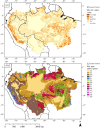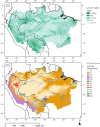Geodiversity in the Amazon drainage basin
- PMID: 38342214
- PMCID: PMC10875704
- DOI: 10.1098/rsta.2023.0065
Geodiversity in the Amazon drainage basin
Abstract
The Amazon is the largest drainage basin on Earth and contains a wide variety of abiotic landscape features. In spite of this, the geodiversity in this basin has not yet been objectively evaluated. We address this knowledge gap by combining a meta-analysis of an existing global geodiversity map and its components with a systematic literature review, to identify the key characteristics of geodiversity in the Amazon drainage basin (ADB). We also evaluate how these global geodiversity component maps, that are based on the geology, geomorphology, soils and hydrology, could be refined to better reflect geodiversity in the basin. Our review shows that geology-through lithological diversity and geological structures-and hydrology-through hydrological processes that influence geomorphology and soil diversity-are the main determinants of geodiversity. Based on these features, the ADB can be subdivided into three principal regions: (i) the Andean orogenic belt and western Amazon, (ii) the cratons and eastern Amazon, and (iii) the Solimões-Amazon river system. Additional methods to map geomorphological and hydrological diversity have been identified. Future research should focus on investigating the relationship between the geodiversity components and assess their relationship with biodiversity. Such knowledge can enhance conservation plans for the ADB. This article is part of the Theo Murphy meeting issue 'Geodiversity for science and society'.
Keywords: Amazonia; geodiversity; geology; geomorphology; hydrology; soils.
Conflict of interest statement
A.C.S. has a joint publication with the guest editors J.J.B., R.F. and F.S. C.H. is co-author in a paper led by guest editor F.S.
Figures








Similar articles
-
Global geodiversity components are not equally represented in UNESCO Global Geoparks.Philos Trans A Math Phys Eng Sci. 2024 Apr;382(2269):20230054. doi: 10.1098/rsta.2023.0054. Epub 2024 Feb 12. Philos Trans A Math Phys Eng Sci. 2024. PMID: 38342215 Free PMC article.
-
Towards a taxonomy of geodiversity.Philos Trans A Math Phys Eng Sci. 2024 Apr;382(2269):20230060. doi: 10.1098/rsta.2023.0060. Epub 2024 Feb 12. Philos Trans A Math Phys Eng Sci. 2024. PMID: 38342205 Free PMC article.
-
Geodiversity data for Europe.Philos Trans A Math Phys Eng Sci. 2024 Apr;382(2269):20230173. doi: 10.1098/rsta.2023.0173. Epub 2024 Feb 12. Philos Trans A Math Phys Eng Sci. 2024. PMID: 38342206 Free PMC article.
-
The status and future of essential geodiversity variables.Philos Trans A Math Phys Eng Sci. 2024 Apr;382(2269):20230052. doi: 10.1098/rsta.2023.0052. Epub 2024 Feb 12. Philos Trans A Math Phys Eng Sci. 2024. PMID: 38342208 Free PMC article. Review.
-
The dilemma of valuing geodiversity: geoconservation versus geotourism.Philos Trans A Math Phys Eng Sci. 2024 Apr;382(2269):20230049. doi: 10.1098/rsta.2023.0049. Epub 2024 Feb 12. Philos Trans A Math Phys Eng Sci. 2024. PMID: 38342217 Free PMC article. Review.
Cited by
-
Geodiversity for science and society.Philos Trans A Math Phys Eng Sci. 2024 Apr;382(2269):20230062. doi: 10.1098/rsta.2023.0062. Epub 2024 Feb 12. Philos Trans A Math Phys Eng Sci. 2024. PMID: 38342210 Free PMC article. No abstract available.
-
The macro-eco-evolutionary interplay between dispersal, competition and landscape structure in generating biodiversity.Philos Trans R Soc Lond B Biol Sci. 2024 Jul 29;379(1907):20230140. doi: 10.1098/rstb.2023.0140. Epub 2024 Jun 24. Philos Trans R Soc Lond B Biol Sci. 2024. PMID: 38913052 Free PMC article.
References
-
- Gray M. 2008. Geodiversity: developing the paradigm. Proc. Geol. Assoc. 119, 287-298. (10.1016/S0016-7878(08)80307-0) - DOI
-
- Gray M. 2004. Geodiversity: valuing and conserving abiotic nature, pp. 1-9. Chichester, UK: John Wiley & Sons, Ltd.
-
- Serrano E, Ruiz-Flaño P. 2007. Geodiversity: a theoretical and applied concept. Geogr. Helv. 62, 140-147. (10.5194/gh-62-140-2007) - DOI
-
- Antonelli A et al. 2018. Geological and climatic influences on mountain biodiversity. Nat. Geosci. 11, 718-725. (10.1038/s41561-018-0236-z) - DOI
Publication types
LinkOut - more resources
Full Text Sources
Miscellaneous

